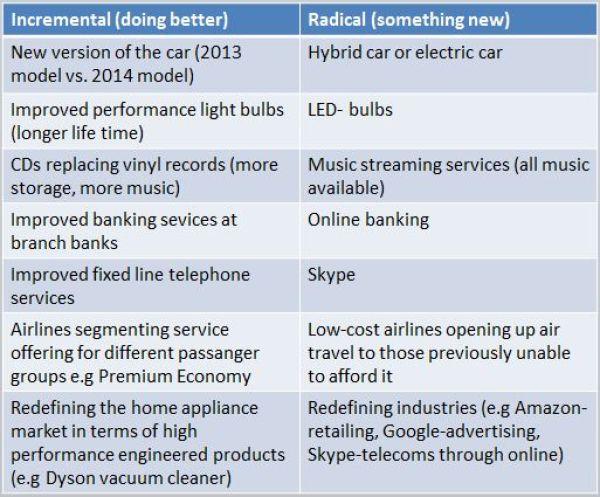Types of innovation
In the world there are many kind of innovation. Those can be classified according to the object of innovation, for example innovation of business model, of products, of services, of processes, of ecosystems, of organizations, just mentioned a few (Norman & Verganti, 2012). Innovation type can be divided into two categories. Categories are radical innovation and incremental innovation. The following chapters are opened what they mean.
At the bottom of this side is a small table where is a comparison of radical and incremental innovations. In order to facilitate the understanding of the difference of radical and incremental innovation examples on the table are taken from the same industry.
Incremental innovation
Incremental innovation improves certain dimensions of the product design or the production process for example. This allows products, services, processes etc. to better meet the needs of specific market segments. Incremental innovation arises under conditions of greater certainty. Market segments are normally known, as well as customer needs. Company’s technology required is not usually very different from the company’s recent practices and the production processes used are well-understood (Lynn et al., 1998). Incremental projects are quite straightforward and they also are characterized by low technical and market uncertainty, and incremental product changes are based on knowledge, experience and capabilities that already exist in the company (Zirger and Hartley, 1994).
Incremental product innovation for example refers to the small changes in a product that helps improve its performance, lower its costs, and/or enhance its desirability or simply to announce a new model release.Good example is new version of mobile phone. Most products are used by continual incremental innovation. That means lowering their costs, and enhancing effectiveness all the time.This is the main form of innovation and even though it is not as thrilling as a radical innovation. Althought incremental innovation is not as thrilling as radical innovation, but it is as important as radical innovation. Incremental innovation is necessary to transform the radical idea into a form that is acceptable to the early adopters (Norman & Verganti, 2012).
Radical innovation
This gives rise to really new products for both the company and the market, involving technological revolutions that totally change the name of the game. Radical innovation usually involves a high level of risk. High risk is involved because a high degree of complexity in the new product requirements, as yet undefined, as well as a high degree of uncertainty with regard to technology, customers’ needs and competitors’ actions (Song and Montoya-Weiss, 1998). When the company faces radical innovation, the technology, market and company’s infrastructure may still be at development stage or at worst non-existent at all (Lynn et al., 1996). Basically radical innovations are a high level of complexity and uncertainty, which increase company’s need for learning, flexibility and adaptability.
Leaders of the companies are aware of that radical innovations are critical to company’s long-term growth and renewal. The relationship between business growth and innovation is widely understood by managers today. Incremental innovation can keep company competitive with current product platforms in current business areas. But only radical innovation can change the game. Radical innovation can transform the relationship between a customer and a company, restructure marketplace, displace current products and often create new product categories (Leifer et al., 2000).
It is obvious that not every company wants to pursue new markets and customers through radical innovation. A radical innovation fails more that successes and the magnitude and timing of results are highly unpredictable. That is one of the reasons why companies don’t want to execute radical innovations so much. Price is quite high if it fails but profit can be also high if it success (Leifer et al., 2000).
Tähän tekstiä table 1:stä!!!
The bottom line is that both forms of innovation are necessary. Radical innovation brings new domains, new paradigms, and creates a potential for major changes. Incremental innovation is how the value of that potential is captured. Without radical innovation,incremental innovation reaches a limit. Without incremental innovation,the potential enabled by radical change is not captured (Norman & Verganti, 2012).
 In English
In English Suomeksi
Suomeksi





